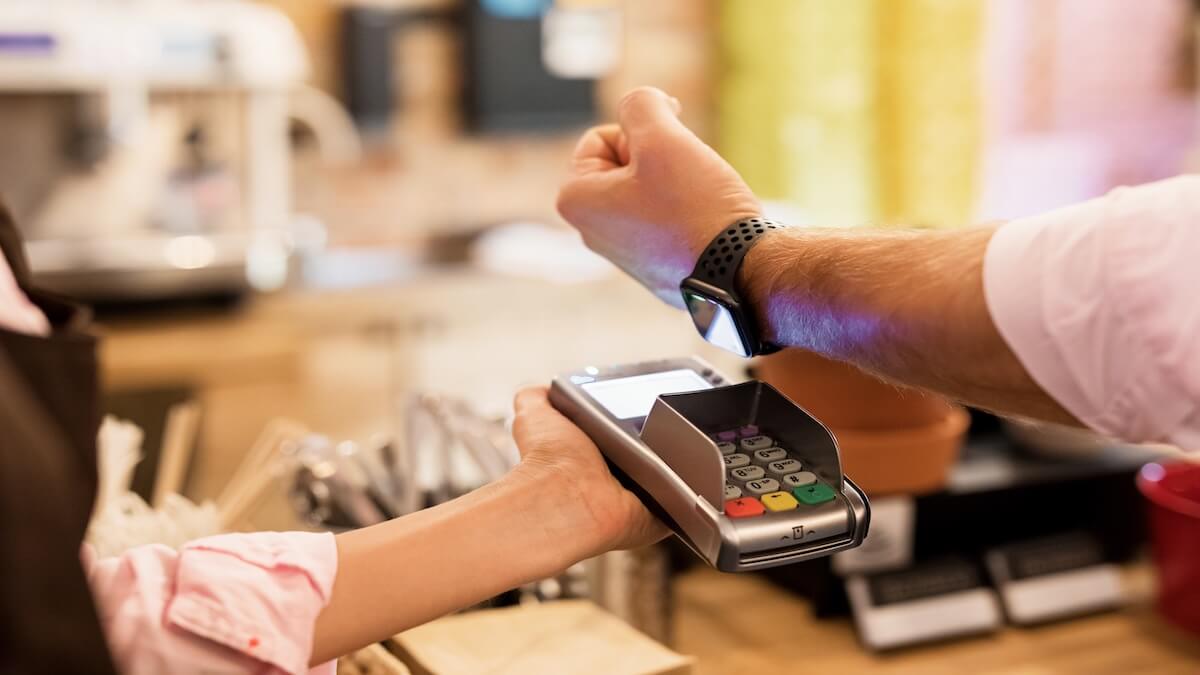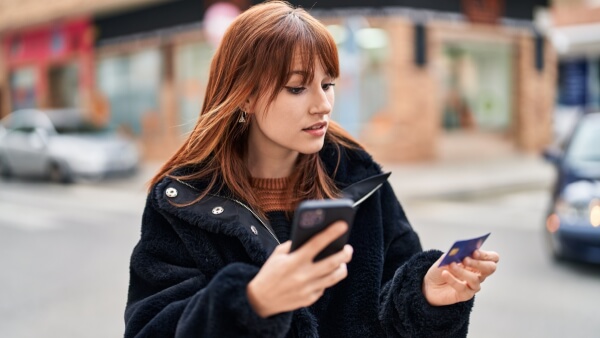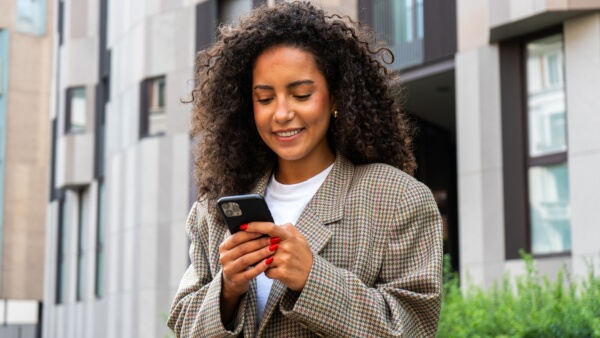How to delete your Remitly account: US guide
Find out how to delete a Remitly account step-by-step and what other alternative transfer services are available.

Apple Pay has become one of the most popular ways for Americans to pay, with over 65 million users worldwide in 2025.¹ With just your iPhone or Apple Watch, you can tap, send, and shop almost anywhere without reaching for your wallet.
But how does Apple Pay work in the US, and is it the right choice for you? Well, in this Apple Pay review, we’ll cover features, pros and cons, costs, and security.
We'll also introduce the Wise account, which allows you to send, spend, and receive your money across the globe in over 40 currencies – all at the fair mid-market rate.
| Table of contents |
|---|
Apple Pay is a mobile wallet and payment service built into iPhones, iPads, Macs, and Apple Watches. Instead of swiping a card, you simply hold your device near a contactless reader or pay online with Face ID or Touch ID.
| 💡 Here’s what you can do with Apple Pay in the US: |
|---|
|
Unlike credit card issuers or banks, Apple itself doesn’t set fees for using Apple Pay —your bank or card provider’s usual terms apply.
Here’s a quick rundown of Apple Pay’s pros & cons in the US:
| ✅ Pros | ❌ Cons |
|---|---|
| Free to use; no extra fees from Apple | Not accepted everywhere, especially outside the US |
| Extra security; card numbers aren’t shared | Requires an iPhone, Apple Watch, or other Apple device |
| Works for in-store, online, and in-app payments | Battery or device issues can stop you from paying |
| Integrated with Apple Cash and Wallet for easy transfers | Some privacy concerns over transaction metadata |
If you’re at least 18 years old and have a compatible iPhone, iPad, Apple Watch, or Mac, you can set up and start to use Apple Pay in a few steps.
Open the Wallet app, tap Add Card, and choose to add a debit or credit card. You can enter the details manually or scan your card with your device’s camera.
After that, your bank or card issuer will verify the information. This might involve a one-time code sent by SMS, email, or through your banking app. Once the card is confirmed, it will appear in your Wallet and be ready to use.
And that’s it. From there, you can pay in stores or online anywhere Apple Pay is accepted, just look for the Apple Pay or contactless symbol at checkout.
Apple Pay itself doesn’t charge fees when you make a purchase online, in-app, or in stores.
You simply use your linked debit or credit card, and the transaction goes through your card issuer. However, depending on how you add money or send money with Apple Cash, fees may apply.
Here’s a quick look at key Apple Pay and Apple Cash fees:²
| Transaction | Fee |
|---|---|
| Account opening fee | Free |
| Monthly fees | Free |
| Add money from a debit/prepaid card | Free |
| Send money with Apple Cash balance or debit card | Free |
| Send money with a credit card | 3% |
| Standard transfer to the bank | Free |
| Instant Transfer to debit card | 1.5% (min $0.25, max $15) |
Keep in mind that Apple sets transaction and balance limits for Apple Cash, which may apply depending on whether you’re using a personal or family account.
These limits can affect the amount you can add, send, or transfer within a specified period.
Apple Pay doesn’t allow you to send money internationally. Apple Cash transfers are only available to users in the US, and you need a US-issued debit or credit card to set up your wallet.
If you’re looking to send money abroad, you’ll need to use another service. With a Wise account, for example, you can send money to 160 countries at the mid-market exchange rate with a transparent upfront fee.
Transaction speed depends on the availability of funds, approval by Apple or your bank, and the availability of partner networks in the system.
In this segment, we’ll review the main features you can use with Apple Pay in the US.
From in-store checkout to Apple Cash and Pay Later, these tools are built into Wallet and designed for everyday convenience.
Apple Pay lets you make purchases in stores, in apps, and on websites without pulling out your card. Transactions are authorized with Face ID or your passcode, so you don’t need to share details with merchants.
Apple reports that over 85% of US retailers now accept Apple Pay as a payment method. You can check if a store accepts Apple Pay by looking for the contactless or Apple Pay logo at checkout.³
Apple Cash is a digital card within Wallet, issued by Green Dot Bank, a Member of the FDIC.⁴
You can:
- Send or request money through Messages
- Spend your Apple Cash balance wherever Apple Pay is accepted
- Transfer funds to a linked debit card or bank account
There are limits to Apple Pay: For verified accounts, balances can’t exceed $20,000, with a max transfer of $10,000 per transaction and $20,000 in a 7-day period.
Apple Pay Later lets eligible users split purchases into four equal, interest-free payments over six weeks. You’ll see upcoming payments in Wallet and get reminders before each installment.
Approval depends on Apple’s checks, and while there are no fees or interest if payments are made on time, late payments may affect eligibility.
If you have an Apple Card, you can link it to Apple Pay to earn daily cash back. Purchases made with Apple Card via Apple Pay earn up to 3% Daily Cash at select retailers like Apple and Uber, and 2% everywhere else.⁵
Cashback is deposited into your Apple Cash balance, where it can be spent or transferred.
Apple Pay transactions use tokenization, meaning your card number isn’t shared with merchants. Each payment requires authentication through Face ID, Touch ID, or a passcode. If your iPhone or Apple Watch is lost, you can suspend or remove the card through iCloud.
Apple also states that it doesn’t store transaction data in a way that can be traced back to you.
If you’re using Apple Pay with Apple Cash, you can add money to your balance directly in Wallet. This gives you funds to spend anywhere Apple Pay is accepted, or to send to friends and family through messages.
Here’s how it works:
You can top up Apple Cash using a supported US debit or prepaid card that’s already linked to your Wallet.
- Open the Wallet app and tap your Apple Cash card
- Select Add Money
- Enter an amount
- Choose the linked debit or prepaid card and confirm with Face ID, Touch ID, or passcode
Funds usually appear in your balance instantly. Apple limits top-ups to $10,000 in a single transfer and $20,000 within a 7-day period.⁶
Apple Cash also supports direct deposit for paychecks or government benefits. Once you’ve verified your identity, you’ll see your account and routing numbers in Wallet.
Provide these details to your employer or benefits provider, and your paycheck will go directly into your Apple Cash balance.
If you use the Apple Card, Daily Cash rewards are automatically deposited into your Apple Cash account. You can then send them with Apple Pay, transfer them to your bank, or save them toward larger purchases.
Apple Pay is designed to keep your money secure. Instead of sharing your actual card number, it creates a unique Device Account Number stored safely on your device.
Every purchase is verified with a one-time dynamic code, which helps protect against fraud.
To pay, you’ll need Face ID, Touch ID, Optic ID, or a passcode. So even if your phone goes missing, no one can use Apple Pay without your approval. You can also suspend cards remotely with the Find My app.⁷
Apple doesn’t track or store your personal transaction data. And for Apple Cash, funds are held by Green Dot Bank, Member FDIC, which means deposits are insured up to $250,000.
Apple Pay makes it easy to pay online and in stores and even send money to friends, all from your iPhone or Apple Watch. It’s secure, widely accepted, and simple to set up.
But while Apple Pay is great for everyday purchases in the US, it isn’t built for international payments. If you’re traveling or sending money abroad, fees and limits can add up quickly.
| With the Wise account you can have local account details in 10 currencies, including USD, EUR, and GBP — all in one place.* |
|---|
*Eligibility is subject to verification of customers' identity.
Sources
Sources checked 09/19/2025
*Please see terms of use and product availability for your region or visit Wise fees and pricing for the most up to date pricing and fee information.
This publication is provided for general information purposes and does not constitute legal, tax or other professional advice from Wise Payments Limited or its subsidiaries and its affiliates, and it is not intended as a substitute for obtaining advice from a financial advisor or any other professional.
We make no representations, warranties or guarantees, whether expressed or implied, that the content in the publication is accurate, complete or up to date.

Find out how to delete a Remitly account step-by-step and what other alternative transfer services are available.

Find out whether Remitly or Wise is better for you in this comprehensive comparison guide, covering fees, limits, transfer times, and more.

Trying to decide between using Ria and Remitly? Find out the main differences, including features, limits, and fees, in this comprehensive guide.

Trying to decide between using Western Union and WorldRemit? Find out the main differences, including features, limits, and fees.

Find out what Remitly is and how it works, including types of money transfers, applicable charges, and limits.

Read on for everything you need to know about sending and receiving wire transfers with Remitly.